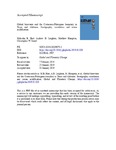Global bioevents and the Cretaceous/Paleogene boundary in Texas and Alabama: Stratigraphy, correlation and ocean acidification
| dc.contributor.author | Hart, Malcolm | |
| dc.contributor.author | Leighton, A | |
| dc.contributor.author | Hampton, M | |
| dc.contributor.author | Smart, Christopher | |
| dc.date.accessioned | 2019-02-13T14:58:46Z | |
| dc.date.issued | 2019-02-01 | |
| dc.identifier.issn | 0921-8181 | |
| dc.identifier.issn | 1872-6364 | |
| dc.identifier.uri | http://hdl.handle.net/10026.1/13301 | |
| dc.description.abstract |
With increasing levels of atmospheric pCO 2 the oceans are becoming progressively more acidic, with the impact of a lowered pH beginning to affect the calcification of numerous invertebrate groups, including foraminifers, pteropods, heteropods and calcareous nannoplankton. Research on the ecology of foraminifera in the Mediterranean Sea, Gulf of California, Caribbean Sea and elsewhere has shown how modern assemblages are responding to acidification. Experimental work in mesocosms and laboratory cultures are also adding to our knowledge of the response to pH changes. Near Ischia (Italy), natural CO 2 vents amongst sea grass meadows are creating low pH environments in which it is possible to observe the response of benthic foraminifera. At a pH of 7.8 the foraminiferal assemblages are already becoming less diverse and below pH 7.6 there are often no calcite-secreting benthic foraminifera. In the Gulf of California, in a deeper-water setting, natural CO 2 (and methane) vents are also lowering sea floor pH. The foraminifera show the impact of this change, although the relatively high carbonate saturation ensures that calcite-secreting foraminifers are able to live and reproduce in these relatively low pH environments, only becoming impacted by dissolution effects once dead. Using data from the Cretaceous–Paleogene boundary in Texas, Alabama and north-west Europe it is clear that the plankton was severely impacted by surface water acidification while the relatively shallow water benthic foraminifera show little change and no visible signs of post-mortem dissolution due to ocean acidification. | |
| dc.format.extent | 129-143 | |
| dc.language | en | |
| dc.language.iso | en | |
| dc.publisher | Elsevier | |
| dc.subject | 14 Life Below Water | |
| dc.title | Global bioevents and the Cretaceous/Paleogene boundary in Texas and Alabama: Stratigraphy, correlation and ocean acidification | |
| dc.type | journal-article | |
| dc.type | Review | |
| dc.type | Journal | |
| plymouth.author-url | https://www.webofscience.com/api/gateway?GWVersion=2&SrcApp=PARTNER_APP&SrcAuth=LinksAMR&KeyUT=WOS:000463982700011&DestLinkType=FullRecord&DestApp=ALL_WOS&UsrCustomerID=11bb513d99f797142bcfeffcc58ea008 | |
| plymouth.volume | 175 | |
| plymouth.publication-status | Published | |
| plymouth.journal | Global and Planetary Change | |
| dc.identifier.doi | 10.1016/j.gloplacha.2019.01.020 | |
| plymouth.organisational-group | /Plymouth | |
| plymouth.organisational-group | /Plymouth/Faculty of Science and Engineering | |
| plymouth.organisational-group | /Plymouth/Faculty of Science and Engineering/School of Geography, Earth and Environmental Sciences | |
| plymouth.organisational-group | /Plymouth/REF 2021 Researchers by UoA | |
| plymouth.organisational-group | /Plymouth/REF 2021 Researchers by UoA/UoA07 Earth Systems and Environmental Sciences | |
| plymouth.organisational-group | /Plymouth/Research Groups | |
| plymouth.organisational-group | /Plymouth/Research Groups/Marine Institute | |
| plymouth.organisational-group | /Plymouth/Users by role | |
| plymouth.organisational-group | /Plymouth/Users by role/Academics | |
| dcterms.dateAccepted | 2019-01-31 | |
| dc.rights.embargodate | 2020-2-1 | |
| dc.identifier.eissn | 1872-6364 | |
| dc.rights.embargoperiod | Not known | |
| rioxxterms.versionofrecord | 10.1016/j.gloplacha.2019.01.020 | |
| rioxxterms.licenseref.uri | http://www.rioxx.net/licenses/all-rights-reserved | |
| rioxxterms.licenseref.startdate | 2019-02-01 | |
| rioxxterms.type | Journal Article/Review |


